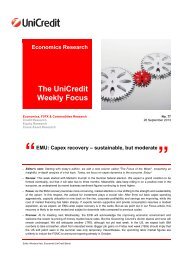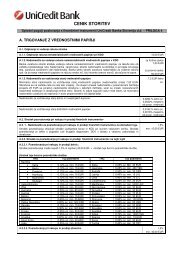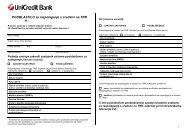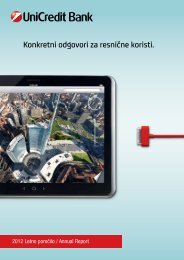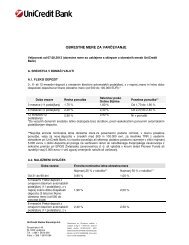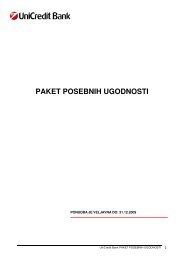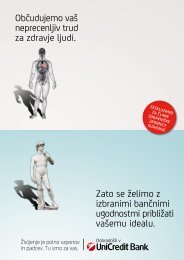Letno poroÄilo 2009.pdf - UniCredit Banka Slovenija dd
Letno poroÄilo 2009.pdf - UniCredit Banka Slovenija dd
Letno poroÄilo 2009.pdf - UniCredit Banka Slovenija dd
- No tags were found...
Create successful ePaper yourself
Turn your PDF publications into a flip-book with our unique Google optimized e-Paper software.
IntroductionStatement by the Chairman of the Management Boardof modifications to credit relations and impairments of receivablesin banks are the next fundamental cause of higher margins or totalcredit costs.• The recession in itself, with the drop in economic growth, broughta general increase in credit risk, while also increasing aggravationof analysis of opportunity costs in relation to new investments. Thismeans that, in principle, there is less interest in investments andalso less demand for credits; ergo, a further cause of higher creditcosts is increased credit risk.• In 2009, growth of domestic savings in the form of various typesof deposits was 50 % lower than the previous year (approx. 5 %),which is the result of the population’s decreased income levels onone side and of poorer companies performance on the other.• The state adopted several measures aimed at solving the situationin the economic and banking sectors, of which the followingthree deserve to be mentioned: the state issued a sovereignguarantee for all deposits expiring at the end of 2010; it adopteda special “guarantee plan”, which is supposed to facilitate creditactivities; and it took a 4 billion euros loan on the European market,relocating part of the funds into banks in order to improve liquidityand simultaneously to create a benchmark for credit costs for othermarket participants.Based on the mentioned assumptions, on which the whole economyand banking sector functioned, it can be said that <strong>UniCredit</strong> <strong>Banka</strong><strong>Slovenija</strong> d.d. achieved and in some instances even surpassed theset goals. This assurance is supported by the following facts:• The Bank’s volume of assets increased by 13 % (thoughsubstantially less than the previous year, when a 36 % increasewas recorded). In other words, it reached a level of 3.2 billioneuros, which ranks the Bank 4 th in Slovenia. It can be seen from astructural property balance that the Bank increased the financingof other banks and, though to a significantly lesser extent, also thefinancing of companies, with a 2 % growth, while crediting of retailclients grew by 14 %.• In 2009, the operating income is on previous year level andamounts to 64.54 million euros.• The Bank’s pre-tax profit dropped by more than 50 % and itreached 11.2 million euros. This is partly due to the lower volumeof loans to all types of clients compared to the previous years, butmainly because of impairments and provisions amounting to 17.0million euros, which is more than twice as much as the previousyear (2008: 7.0 million euros). These results indicate that theoperational profit of the Bank in 2009 amounted to 26.9 millioneuros, compared to 30.4 million euros in 2008, representing a dropof merely 12 %, despite the significant drop in the growth of thevolume of assets and the total volume of loans.• Within the framework of these types of profits, the highestpercentage is represented by net interest income, which amountedto 40.7 million euros and decreased by 10 % over the previous year.On the other hand, non-interest income amounted to 25.4 millioneuros, which is approximately 16 % more than in 2008.• The various measures adopted by the Bank in the area ofrationalisation brought a decrease in administrative costs excludingdepreciation of 4 %, specifically, from 33.0 million euros in 2008,costs dropped to 31.8 million euros in 2009. Costs of salariesremained virtually unchanged at 18.7 million euros in both years.Total operational costs decreased by 1 % and reached 36.2 millioneuros, while in 2008 they amounted to 36.6 million euros; thestrongest factor affecting the costs increase being investments intobusiness network expansion in the second half of 2008 in the formof a<strong>dd</strong>itional deprecation, as well as the cost of information systemupgrades.Despite significantly changed and deteriorated business conditions,compared to other financial intermediaries, the Bank is satisfied withthe results it achieved. Hereby we refer to the fact that other financialintermediaries recorded a 34 % drop in profits as early as in 2008,while the Bank continued to reach 20 % growth.For the achieved results, we would first like to thank our partners forthe trust they place in us. With their help, the Bank ranks first in thefield of derivatives (reaching almost 50 % of the Slovenian market),first on the Ljubljana Stock Exchange, and holds one of the highestshares in custody services. All these activities had a fundamentalimpact on the growth of non-interest income, which remained withinpositive values despite the crisis.Thanks also go to our owners, namely the <strong>UniCredit</strong> Group which, withthe help of a<strong>dd</strong>itional capital, improved our capital adequacy to almost10 %, thus enabling the Bank's organic growth.Special thanks also go out to all the members of the SupervisoryBoard, as well as of the Control Committee, for their recommendations,which the Bank has made good use of in performing its various dailyactivities.Since two members of the Management Board, Dr. Heribert Fernau andMag. Stefan Vavti, concluded their mandate with the Board after more Operational profit equals to the pre-tax profit increased by the impairments and provisions.122 2009 Annual Report · <strong>UniCredit</strong> Bank



